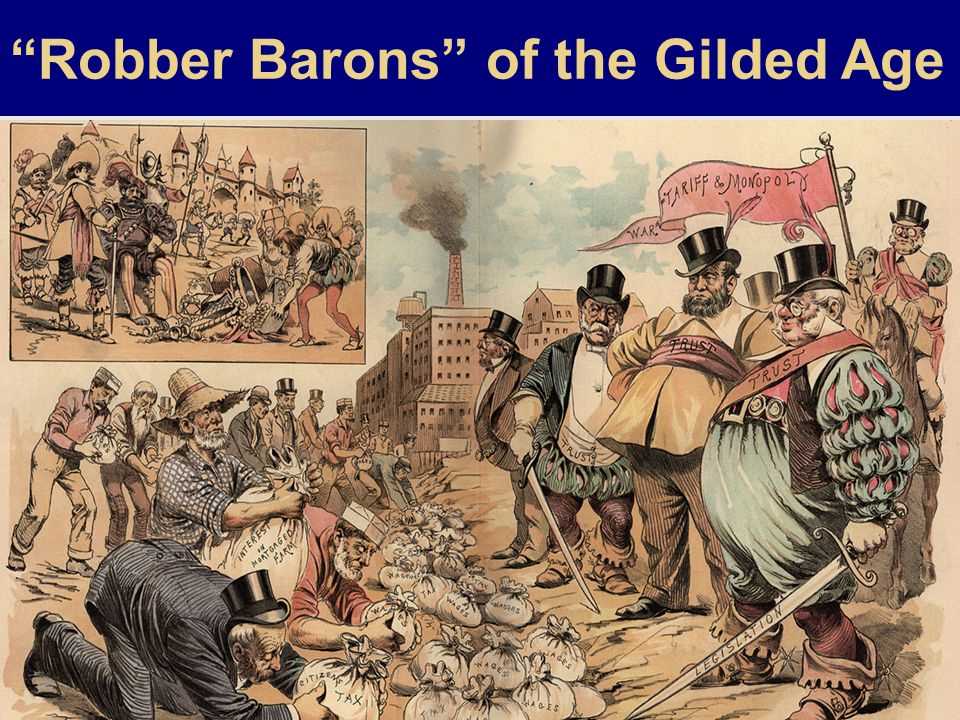
The Gilded Age was a period of rapid economic growth and industrialization in the United States from the late 19th century to the early 20th century. It was a time of immense wealth and extreme inequality, characterized by the emergence of industrial tycoons and robber barons who amassed great fortunes at the expense of the working class.
During this era, the country experienced rapid urbanization, with millions of people moving from rural areas to cities in search of employment opportunities. As factories sprung up across the nation, new technologies and inventions revolutionized the way goods were produced and transported, leading to unprecedented levels of economic growth.
However, beneath the surface of prosperity and progress, the Gilded Age was also marked by significant social and political challenges. The wealth gap between the rich and the poor widened, leading to growing social unrest and labor strikes. There were widespread corruption and political scandals, as politicians and businessmen colluded to amass even more wealth and power.
In this “Gilded Age Test Review” article, we will explore the key events and figures of this era, as well as the social, economic, and political impact it had on the United States. We will delve into topics such as the rise of big business, the labor movement, immigration and urbanization, political corruption, and the changing role of women. By understanding this pivotal period in American history, we can gain insights into the challenges and opportunities the nation faced during its journey towards modernity.
Gilded Age Test Review

In preparation for the upcoming Gilded Age test, it is important to review the major events, key figures, and significant policies of this period in American history. The Gilded Age was characterized by rapid industrialization, economic growth, and technological advancements, while also marked by social inequality, political corruption, and labor struggles.
1. Major Events:
- The completion of the First Transcontinental Railroad in 1869, which connected the east and west coasts of the United States.
- The Haymarket Square Riot of 1886, a violent clash between labor protesters and the police in Chicago.
- The Homestead Strike of 1892, a labor dispute between the Carnegie Steel Company and its workers in Pennsylvania.
- The Panic of 1893, a financial crisis that caused widespread unemployment and economic hardship.
2. Key Figures:
- Andrew Carnegie – a prominent industrialist and philanthropist who built a steel empire.
- John D. Rockefeller – an oil magnate who controlled a significant portion of the nation’s oil industry.
- Thomas Edison – an inventor and businessman known for his contributions to the development of electric power and the light bulb.
- Jane Addams – a social reformer and co-founder of Hull House, a settlement house in Chicago.
3. Significant Policies:
- The Sherman Antitrust Act of 1890, which aimed to regulate and prevent monopolistic business practices.
- The Pendleton Civil Service Reform Act of 1883, which established a merit-based system for government employment.
- The Chinese Exclusion Act of 1882, which restricted immigration from China and was one of the earliest federal laws to limit immigration based on nationality.
By reviewing these major events, key figures, and significant policies of the Gilded Age, you will be well-prepared for the upcoming test and have a deeper understanding of this complex and transformative period in American history.
Overview of the Gilded Age
The Gilded Age, a term coined by Mark Twain, refers to the period of American history from the 1870s to the early 1900s. It was characterized by rapid industrialization, economic growth, and widespread corruption. The name “Gilded Age” implies that while there was an appearance of great prosperity and wealth on the surface, there were underlying social problems and inequalities.
One of the defining features of the Gilded Age was the rise of big business and the expansion of industrialization. This period saw the development of industries such as steel, oil, and railroads, which brought immense wealth to a small group of industrialists, such as John D. Rockefeller and Andrew Carnegie. These tycoons amassed great fortunes, becoming some of the richest people in history.
The Gilded Age was also marked by significant social disparities and a growing divide between the wealthy elite and the working class. While the industrialists thrived, many workers faced difficult and dangerous working conditions, low wages, and long hours. This led to the rise of labor movements and strikes as workers sought to improve their conditions and fight for their rights.
Another notable aspect of the Gilded Age was the rampant political corruption and influence of big business. Politicians were often beholden to the interests of wealthy industrialists, leading to a lack of regulation and accountability. This era is known for its infamous scandals, such as the Credit Mobilier scandal and the Tweed Ring, which revealed the extent of corruption in both the government and business.
In conclusion, the Gilded Age was a transformative period in American history characterized by rapid economic growth, social disparities, and political corruption. It laid the foundation for the modern industrial economy and set the stage for the progressive reforms that would emerge in the early 20th century.
Key Players and Events
The Gilded Age was a period of rapid industrialization and economic growth in the United States during the late 19th century. There were several key players and events that shaped this era, contributing to its nickname as the Gilded Age.
Industrialists and Captains of Industry
One of the key players during the Gilded Age were the industrialists and captains of industry, individuals who amassed great wealth and power through their businesses. People like Andrew Carnegie, John D. Rockefeller, and J.P. Morgan dominated industries such as steel, oil, and finance, respectively. These individuals were known for their ruthless business tactics and their ability to amass vast fortunes.
Andrew Carnegie, for example, was a Scottish-born immigrant who built a steel empire and became one of the richest men in the world. He revolutionized the steel industry by implementing innovative production methods and vertical integration. John D. Rockefeller, on the other hand, dominated the oil industry through his company Standard Oil, using aggressive tactics such as undercutting prices and buying out competitors.
Robber Barons and Trusts

Another important aspect of the Gilded Age was the rise of the robber barons and the formation of trusts. Robber barons referred to wealthy individuals who were accused of exploiting workers, engaging in unfair business practices, and amassing wealth at the expense of the working class. These individuals were seen as corrupt and unethical.
The trusts, or large combinations of companies, were used by the industrialists to consolidate their power and eliminate competition. These trusts, such as the Standard Oil Trust, allowed individual companies to control a significant portion of the market and manipulate prices. The formation of trusts contributed to the unequal distribution of wealth and the concentration of economic power in the hands of a few.
Political Reforms and Populism
The Gilded Age also witnessed various political reforms and the rise of populism. As the divide between the rich and the poor grew wider, there was a growing discontent among the working class and rural farmers. This led to the emergence of populist movements, such as the People’s Party, which advocated for reforms that would address the economic inequalities and political corruption.
Important political events during this period included the passage of the Sherman Antitrust Act in 1890, aimed at curbing the monopolistic practices of the trusts, and the Populist Party’s influence in the 1896 presidential election. While these reforms and movements had some impact, the overall power and influence of the industrialists and the continued concentration of wealth remained significant features of the Gilded Age.
Economic Boom and Inequalities
The Gilded Age was a period of immense economic growth and industrialization in the United States. It was characterized by a rapid expansion of industries such as railroads, steel, oil, and manufacturing. This economic boom was fueled by technological advancements, increased productivity, and the availability of vast natural resources. However, this period of prosperity was also marked by significant inequalities between the rich and the poor.
Income inequality was one of the most striking features of the Gilded Age. The wealth gap between the upper class and the working class widened dramatically during this time. The rise of industrial capitalism created a small group of wealthy individuals who controlled a large portion of the nation’s wealth, while the majority of the population struggled to make ends meet. This led to a growing divide between the haves and the have-nots, with the rich becoming richer and the poor becoming poorer.
The exploitation of labor was another key aspect of the economic inequalities during the Gilded Age. Industries relied heavily on low-wage labor, often in hazardous working conditions, to maximize profits. Workers faced long hours, low wages, and lack of job security. Child labor was also prevalent during this time, with many children forced to work in factories and mines to support their families. The working class had little power or voice, and were often subject to the whims of their employers.
- The lack of government regulation and intervention further contributed to the inequalities of the Gilded Age. With minimal labor laws and regulations in place, businesses were able to operate with little regard for the well-being of their workers.
- Corruption and bribery were widespread, with wealthy individuals and corporations using their money and influence to gain favorable treatment from the government.
- The phenomenon of the “Robber Barons” emerged during this time, referring to the wealthy businessmen who exploited workers and monopolized industries.
In conclusion, while the Gilded Age was a period of incredible economic growth, it was also a time of significant disparities. The rich benefited greatly from the economic boom, while the working class struggled to make a decent living. Income inequality, labor exploitation, and lack of government regulation were all factors that contributed to these economic inequalities during this time.
Rise of Big Business
During the Gilded Age, the United States experienced a significant rise of big business. This period, which spanned from the late 19th century to the early 20th century, was characterized by rapid industrialization and economic growth. As a result, large corporations emerged in industries such as oil, steel, railroads, and finance, consolidating their power and transforming the American economy.
One key factor that contributed to the rise of big business was the technological advancements of the time. Innovations such as the Bessemer process, which revolutionized steel production, and the invention of the telegraph and telephone, improved communication and transportation networks, creating new opportunities for entrepreneurs. These advancements allowed businesses to scale up their operations, increase productivity, and expand into new markets.
With the rise of big business, came the rise of influential entrepreneurs and industrialists. Men like John D. Rockefeller in the oil industry, Andrew Carnegie in steel, and Cornelius Vanderbilt in railroads amassed immense wealth and power. Through innovative business practices, such as vertical integration and trust formations, these captains of industry were able to dominate their respective industries and establish vast empires.
However, the rise of big business was not without its controversies. Critics argued that these corporations wielded too much power, often engaging in unfair business practices such as monopolies, price fixing, and the exploitation of workers. As a result, calls for regulation and anti-trust laws arose, leading to the eventual passage of legislation such as the Sherman Antitrust Act in 1890.
Labor Unrest and Struggles

Labor unrest and struggles were prevalent during the Gilded Age as workers began to organize themselves into labor unions to fight for better working conditions, fair wages, and improved working hours. The rapid industrialization of the United States led to the exploitation of labor, with workers often subjected to long hours, low pay, and unsafe working conditions.
One of the most notable labor movements during this period was the Great Railroad Strike of 1877. It began when the Baltimore and Ohio Railroad announced another wage cut, leading to strikes and protests by railroad workers across the country. The strike quickly escalated into a nationwide labor uprising, with strikers shutting down railroads and engaging in violent clashes with law enforcement and armed militias. The strike eventually ended with the intervention of federal troops, but it highlighted the growing tension between labor and capital during the Gilded Age.
Labor unions played a significant role in the struggle for workers’ rights during the Gilded Age. The American Federation of Labor (AFL), founded in 1886, became one of the largest and most influential labor organizations of the time. Led by Samuel Gompers, the AFL focused on collective bargaining and advocating for the interests of skilled workers. The AFL fought for higher wages, shorter working hours, and better working conditions, often resorting to strikes and boycotts to achieve their goals.
- Another important labor organization was the Knights of Labor, founded in 1869. Unlike the AFL, the Knights of Labor aimed to unite all workers regardless of skill level or occupation.
- The Haymarket Affair in 1886, where a peaceful labor protest in Chicago turned into a violent clash between workers and police, further intensified the labor movement. The incident led to the execution of several anarchist labor activists, further fueling the tensions between labor and capital.
The labor unrest and struggles during the Gilded Age marked a significant period of social and economic transformation in the United States. While the labor movement faced many challenges and setbacks, it laid the groundwork for future advancements in workers’ rights and helped shape the development of labor laws and regulations.
Political Corruption and Reform Efforts
The Gilded Age saw a significant rise in political corruption as wealth and power became concentrated in the hands of a few elite individuals. Many politicians were easily swayed or outright bought by wealthy industrialists, who used their influence to shape legislation and ensure favorable policies for themselves and their businesses. This corruption led to widespread public discontent and a growing call for reform.
Efforts to combat political corruption took various forms during this period. One significant reform movement was the Progressive Era, which sought to address the social, economic, and political problems caused by the excesses of the Gilded Age. Progressives advocated for government regulation of businesses, the promotion of social welfare, and the enactment of anti-corruption laws.
- Muckrakers: Journalists known as muckrakers played a crucial role in exposing political corruption and the abuses of the wealthy during the Gilded Age. Their investigative reporting shed light on the corrupt practices of powerful individuals and helped create public awareness about the need for reform.
- Direct Election of Senators: Prior to the Progressive Era, senators were chosen by state legislatures rather than by direct popular vote. The 17th Amendment, ratified in 1913, changed this by allowing for the direct election of senators, thereby reducing the influence of corrupt political machines.
- Progressive Legislation: Progressive lawmakers pushed for and successfully enacted several key pieces of legislation aimed at curbing political corruption. These included the Pure Food and Drug Act, which prohibited the sale of adulterated or mislabeled food and drugs, and the Federal Reserve Act, which established a central banking system to oversee the economy and prevent financial abuses.
- Women’s Suffrage: The women’s suffrage movement gained traction during the Progressive Era, with women demanding the right to vote as a means of combating corruption and advocating for social justice. The ratification of the 19th Amendment in 1920 granted women the right to vote, further diversifying the electorate and potentially reducing the influence of corrupt politics.
Despite these reform efforts, political corruption continued to be a problem in American society, and it still persists to some extent today. The Gilded Age serves as a reminder of the dangers of unchecked power and the importance of ongoing efforts to combat corruption and ensure a fair and transparent political system.